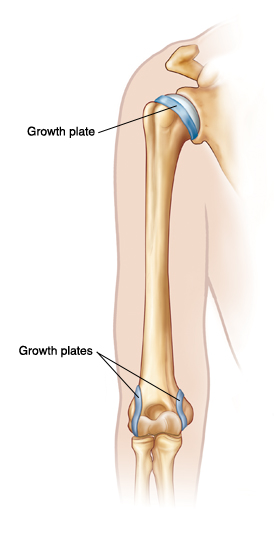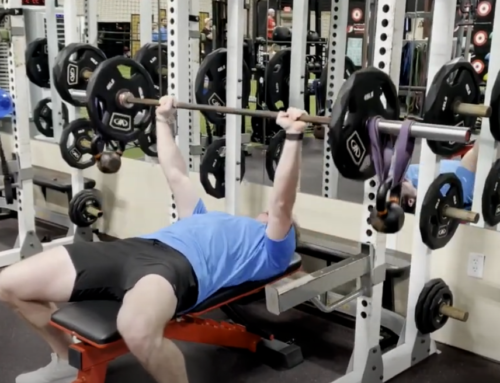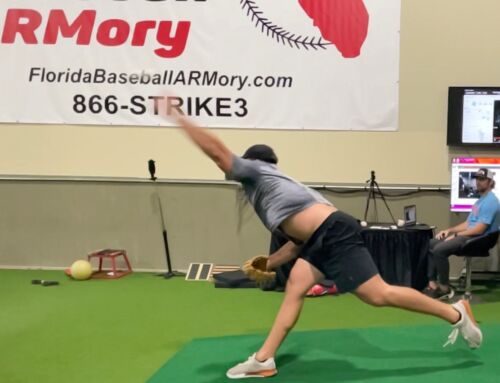
What Is a Growth Plate Injury?
At The ARMory, we work with players of every age and experience level. It’s not uncommon to have a major league client on site, but it’s also not unusual to see a cool 9 year-old running around .
Since we do work with our fair share of younger players, we field a lot of questions about growth plate injuries.
So what are growth plate injuries, and how do they occur?
First let me tell you what they are not… usually they are not catastrophic. So when you find that your son or daughter, or one of your players has suffered a growth plate injury there is no need to panic. Most of the time, a simple period of rest is all they need to get back on track.

Think of growth plates as little factories, manufacturing bone cells and depositing them on the bone to make it longer. There are several growth plates in the shoulder and the elbow. When an athlete is fully grown, these growth plates fuse and the factory shuts down. At younger ages, growth plates are highly active and vulnerable to stress.
When exposed to abnormal stress, the body will usually break at its weakest link. In older athletes, the weak link is the connective tissue (rotator cuff, labrum, UCL). In the younger population the weak link is the growth plate.
Not all growth plate injuries are the same. In our baseball training camps and programs, we treat growth plate injuries very differently depending on the type of injury. If you’re dealing with a growth plate injury, it’s good to understand the classifications.
Classifying Growth Plate Injuries
The Salter-Harris classification is a simple and easy to remember system to identify the nature and severity of a growth plate injury. It uses the name “Salter” as a pneumonic memory jogger. According to sketchymedicine.com, it goes like this:
- SEPARATED (the bone and the growth plate have come apart) – but it actually looks normal on x-ray (you can only tell on physical exam)
- Fracture ABOVE the growth plate
- Fracture LOWER than (below) the growth plate – fracture extends to the articular surface
- Fracture THROUGH the growth plate
- Fracture ERASING/compressing/squashing the growth plate – this is the worst kind because with disruption of the growth plate comes disruption of growth. Type “ER” injuries are usually caused by rare occurrences such as frostbite, electric shock and irradiation. They’re hard to see on x-rays but show up on MRIs.
Depending on the classification of the injury, treatment could range from simple rest, to casting, to surgery.
Most of the growth plate injuries we see are of the “S” variety — the growth plate becomes separated, and manifests itself in the form of pain. This type of injury may or may not be seen on x-ray. But, if a young athlete experiences persistent pain in the shoulder or the elbow, you should be suspicious of a growth plate injury.
The same variables that contribute to soft tissue injuries in the older athlete, also place the growth plates at risk. I discussed these factors at great length in my book, Start With The Pain: The Complete Guide To Managing Arm Pain In The Elite Throwing Athlete, but as a review, here they are again in order of significance:
Type 1 contributors: structural/physical related (tightness, weakness, asymmetries, imbalances, etc…)
Type 2 contributors: movement pattern related.
Type 3 contributors: tissue preparation and recovery.
Type 4 contributors: training related factors.
Type 5 contributors: workload (pitch counts, innings limits).
Type 6 contributors: nutrition, hydration, sleep, and psychological stress.
What We Do For Non-Growth Plate Injuries
Coaches at our baseball training camps know that, when you have a soft tissue injury (UCL, labrum, rotor cuff) that doesn’t result in catastrophic failure, it’s very important during the rehab process that you provide controlled stress to organize the healing tissue along the line of resistance. It’s a concept known as Davis’s Law – a physiologic precept stating that all connective tissue in the human body organizes itself to resist the stresses under which it is placed. For this reason, in the case of soft tissue injuries to the throwing athlete, rest may be the worst thing you can do. If the tissue is not completely disrupted, it needs a mechanical signal to guide reorganization as it heals. This is when we recommend light throwing or throwing in the TAP® Training Sock for players recovering from non-surgical arm injuries. To learn more about the TAP® Training Sock, CLICK HERE.
How We Manage Growth Plate Injuries
When it comes to growth plate injuries, tissue reorganization is not the primary goal. Protecting the growth plate and preventing the injury from progressing to a more serious situation is the order at hand. In that regard, the growth plate injury is one of the few throwing disorders for which I would indeed prescribe total rest. An acceptable amount of rest could range from 2-8 weeks depending on the nature and severity of the injury. By “rest”, we mean avoidance of throwing, not complete cessation of all training activities.
When working with injured players, one of our mantras is, “Never let what you can’t do keep you from doing what you can.” While the athlete is waiting for his growth plate aggravation to subside, he should work to eliminate any possible limitations in stability and/or mobility that might have contributed to the problem. Learning to hinge, lock, and close the pelvis will help him attenuate stress on the arm once he’s read to resume throwing. For more on our revolutionary “Hinge it, Lock it, Close It, Pop It” concept, CLICK HERE.
During this time, the young athlete can also learn a quality warm-up and recovery process that will serve him well when he eventually resumes throwing activities.
After Rest Period
After the appropriate rest period has elapsed, it is extremely important to address all the movement pattern related variables that might have contributed to the injury. A video analysis of the throwing pattern should reveal any arm action of lower half inefficiencies that might have combined with structural, preparation, recovery, or training related factors that could have created an environment for the injury to occur. From this analysis, an individualized corrective throwing plan can be designed and executed.
Frequency, intensity and volume of throwing should always be ramped up gradually, monitoring the athlete for any report of pain.
If you are the parent or coach of a young thrower, awareness of the possibility of a growth plate injury could lead to early detection, intervention and avoidance of a more severe injury.
Do you need to get an x-ray or a MRI immediately if your adolescent thrower reports pain?
Probably not.
Most growth plate injuries are relatively benign and respond well to brief rest. However, in the case of intense, intolerable pain, or if the pain persists even after a couple of weeks of rest, it may be helpful to seek out imaging to get a more clear picture of the situation and possible treatment options.
Are you having arm pain? If you are, I’m sure you’d like to get it settled. If you don’t take care of it now, at best it could nag you throughout the rest of the year and at worst it could evolve into something more serious.
We literally wrote the book on arm pain management. Give us a call at 866-STRIKE3 (866-787-4533) and let us set you up with a Precision Strike One Day, One-on-One Evaluation and Training Plan.
We’ll do a total body physical exam and a video analysis to identify any variables that might be contributing to your pain. We’ll work with you to develop a training plan tailored to your specific needs and we’ll help you return to pain free throwing quickly and safely.
We can’t wait to see you at The ARMory.
Get started by calling, our CFO/COO Amy, at 866-787-4533.

Randy Sullivan, MPT, CSCS CEO, Florida Baseball ARMory




